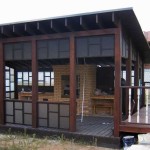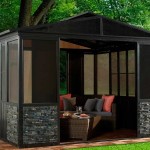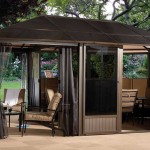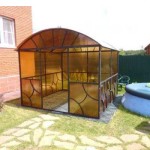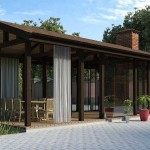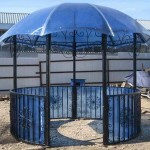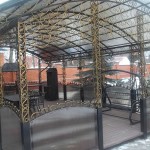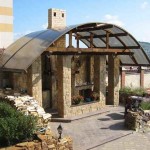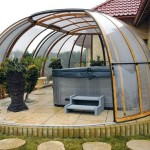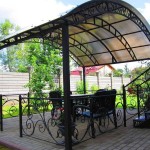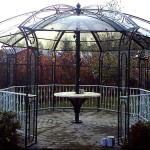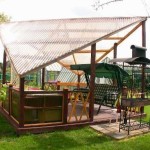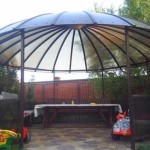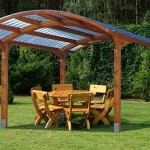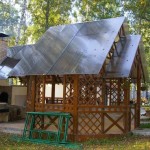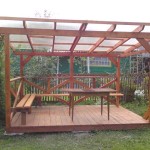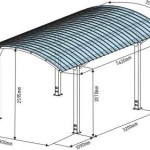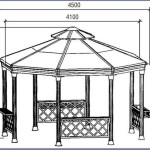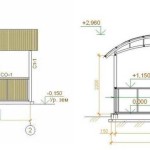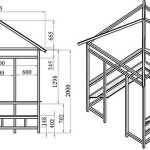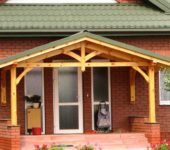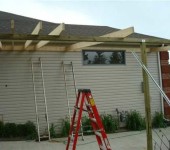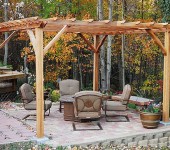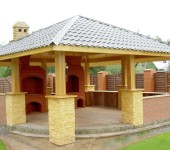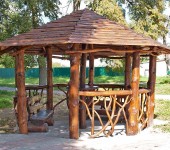How to make a gazebo made of polycarbonate: photos, videos, drawings
Recently, buildings with polycarbonate are becoming more and more popular. The material is inexpensive, aesthetically pleasing, has high plasticity, which allows it to design non-linear surfaces. At dachas or near the house, arbors are increasingly made of polycarbonate. It is used for roof and / or wall decoration, some for glazing. There are both successful experiences and not so good ones. We will tell you what you need to consider in order for your building to be classified as "successful".
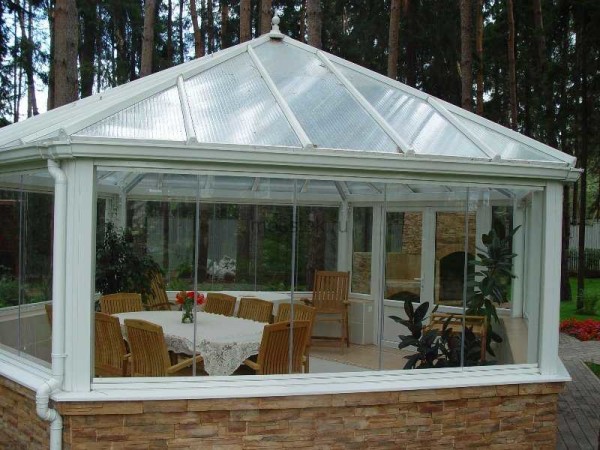
Milky plastic on the roof, "glazing" - of transparent
The content of the article
Experience of use
If you ask about the reviews about polycarbonate gazebos, a very strange picture is observed: some are satisfied, others are not. Moreover, both are categorical, opinions are expressed for a reason, but on the basis of their own experience. Two contradictions emerge from these reviews:
- It is hot under polycarbonate even in an open gazebo. However, not all. Someone there even at noon has a shadow "like under trees."
- The roof was hit with hail, and through and through. Someone has hail, and even stones run by "good" passers-by can withstand.

Polycarbonate is monolithic and cellular
If you understand everything, everything is understandable. There are two types of polycarbonate: honeycomb (cellular) or monolithic (cast). Both can be used for individual construction. Monolithic is a material that was previously called plexiglass. If it is thick enough, its strength is very high: the glazing in some jars is made of monolithic polycarbonate. It is, however, covered with a special protective film - so as not to scratch. If such polycarbonate is laid on the roof of the summerhouse, then it will withstand the stones. But. It costs two or three times more than a cell phone.
Cellular or cellular polycarbonate, as the name implies, consists of cells that are somewhat similar to honeycombs. This is where the name comes from. It is formed by several thin sheets, which are interconnected by jumpers. There can be from two to six layers, and the cells can be of different shapes. Some of the structures are shown in the photo below. Looking at this figure, it is easy to explain the contradictions described above, even if all who wrote the reviews used cellular polycarbonate.
The cheapest material consists of two sheets connected by vertical bridges. Here it is - fragile and brittle. It can be easily squeezed even with your fingers. Especially if the cell is large. The more complex the structure, the stronger the material. How do you know which one is in front of you? Look at its cross section. The geometry of the cells is visible there. This is about the strength and fragility of polycarbonate.
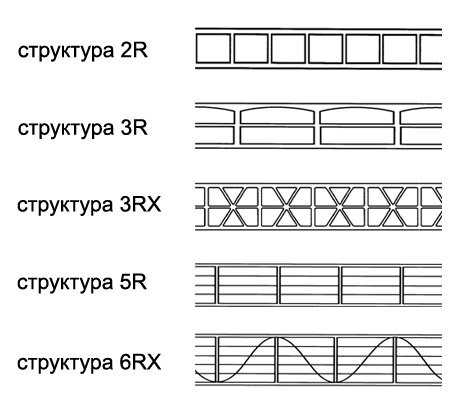
The structure of cellular polycarbonate
Now about the fact that some are hot under the polycarbonate, but some are not. There are two factors that influence this. The first is regional. In some regions, the sun does not bake even in the middle of summer, but warms, and not very much. And even if the polycarbonate is chosen that is used in greenhouses - which allows 80-90% of the sun's rays to pass through - this does not frighten people, but pleases: it is pleasant to warm up.
The second factor is the wrong type of material. As already mentioned, there is polycarbonate, which transmits the sun's rays almost completely. It is used for greenhouses. There is one that transmits about 30% of the light. Here it should be placed on the roofs of gazebos or used for awnings. That's not all. Both the structure and the thickness of the material influence the thermal insulation characteristics: the more layers, the better the thermal insulation properties.In the case of a gazebo, it is not hot under thick polycarbonate (8 mm) in the gazebo, even in the southern regions. The situation is, in general, familiar: cheap materials have a low price for a reason. So do not save: it will be hot, and even beat up with hail.
What are the polycarbonate gazebos
In form - any. It is difficult to make a very sharp bend - the minimum radius is six times the thickness of the sheet, but this is not needed when building arbors. All other shapes can be sheathed.
If we talk about cellular polycarbonate, then it is mounted on some kind of frame. It lacks its own bearing capacity. Monolithic with sufficient thickness - from 8 mm - can be mounted without any supports. But it is used very rarely, therefore, we will not talk about it further.
Polycarbonate is attached to any gazebos, but most often - on metal... It looks especially beautiful with forged. A roof made of a different material will "land" the structure, and the translucent plastic looks weightless and does not attract attention, only emphasizing the beauty of the patterns. Several photos of polycarbonate gazebos are collected in the photo gallery, which is located below (scroll through the arrows or by clicking on the icons, you can zoom in on the full screen).
- The gazebo turned out to be very attractive from a bar, painted with dark and milky polycarbonate. The roof in this version is made of soft tiles
- This is a closed gazebo made of glazed on a metal frame
- These are two in one: open from a closed gazebo
- Metal sheathed with orange polycarbonate - even on a cloudy day it will be "sunny" in the gazebo. This is a great option for regions where the sun is a rare guest.
- Wood and polycarbonate are a rare pair
- Blue looks great, but the faces of people sitting in such a gazebo are of a strange color ...
- High patterned pillars, decorative arches. The structure turned out to be weightless
- Stone, wood, polycarbonate - a beautiful and stylish combination
- Due to the flexibility of the material, you can create rounded shapes
- Arbor with forged elements
- The polycarbonate domed roof is custom made. Unusual gazebo turned out
- An excellent option for a wooden gazebo with a honeycomb polycarbonate roof
- An unusual dome over a large area
- Open gazebo in the meadow
- A very interesting option: the design follows the shape of the house
- Gazebos with a pitched roof are rare.
ABOUT types and features of brick and stone arbors are written here.
Installation features
During any construction, there is always a struggle: on the one hand, I want to save money, on the other, to make it beautiful, high-quality and reliable. In the case of polycarbonate, it is better not to save money. Firstly, the quality strongly depends on the manufacturer, and secondly, even buying a thin sheet, you will save a little in the end. After all, the step of the lathing depends on the angle of the slope and the thickness of the polycarbonate: the smaller the thickness, the more often you need to install the lathing. Well, and a number of other reasons why this should not be done, we discussed above.
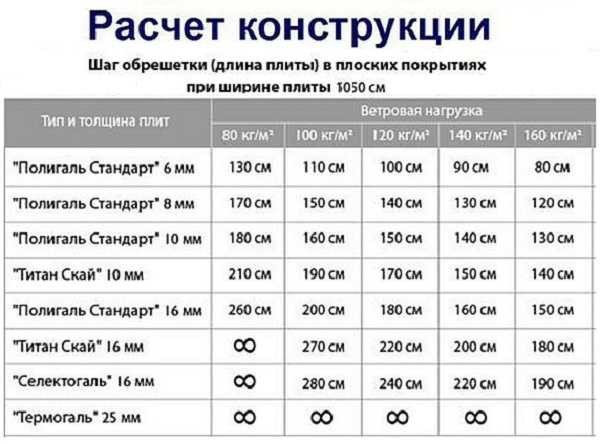
Each manufacturer has a similar table. But already from this it is clear that the thinner the sheet, the more often it is necessary to make the crate
What can be the basis for polycarbonate? Any material: wood, plastic, metal. If polycarbonate is mounted on a tree, it must be treated with antiseptics that will prevent fungi and bacteria from multiplying. This is because condensation forms between the plastic and the wood. High humidity creates conditions for the development of fungi.
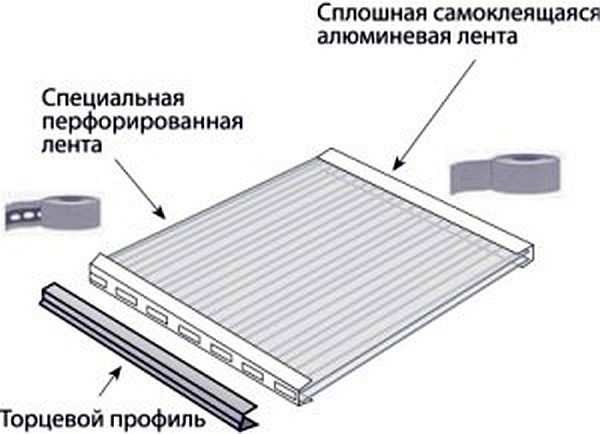
The ends of the slabs must be closed
Another problem may arise when laying on metal. It gets very hot under the sun; plastic heats up in small areas from it. This phenomenon leads to the fact that it swells over the metal frame.To avoid local overheating, a thin layer of heat-insulating material is glued to the metal. If you buy polycarbonate from a reputable manufacturer, self-adhesive thermal insulation tapes are included in the kit. If the material is "unknown", any dense and flexible material with appropriate characteristics can be used. Rubber and cork come to mind first, but a strip of felt, thin foamed polyethylene, etc. may work. You will have to glue it on the sealant.
If the base is plastic pipes, there are no problems: the materials have similar characteristics, coexist without problems.
The process of making a carport from polycarbonate is described here.
What and how to cut
You can cut polycarbonate sheets with any tool that works with wood. This is a hand saw, a jigsaw, a grinder with a disc for wood.
You can cut both along and across the honeycomb. The ends of the cross-sections must be sealed. When buying branded materials, you will be offered a sealing tape (glued to the upper cut) and perforated tape (covers the cut at the bottom, and perforation - to remove water vapor or condensation drops), which are glued to the cut. If you do not have such tapes, you can cover the honeycomb with a transparent sealant, but so that there are no cracks.
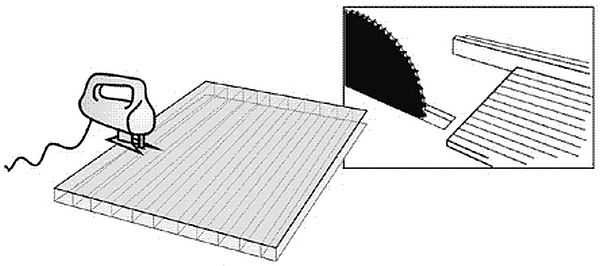
Cut sheets with a jigsaw or grinder
Why can't they be left open? First, dust, debris gets into them, which over time makes the roof or walls untidy and almost opaque. Secondly, when air enters, condensation forms on the walls, and microscopic green algae perfectly reproduce in it in the light. And the polycarbonate becomes a strange color, and at the same time ... ugly.
After the sheet has been cut, the honeycomb must be cleaned of dust trapped in it. This is best done with a vacuum cleaner. Then close up the honeycomb.
About, read how to build arbors from wood here.
How to fix
During installation, it is important to remember that polycarbonate for the roof on one side has a protective coating against ultraviolet radiation. It cuts off the harmful spectrum. On this side, manufacturers stick a film with logos. When mounting roofs or walls, this film should be on top. It is removed immediately after editing. Not "before" - so as not to scratch, and not in a week - the film will stick to the light, and it will be problematic to remove it.
For fasteners, special thermal washers with plugs or bolts with a mandatory metal and rubber washer are used. A hole is pre-drilled for each fastener. Its diameter should be 3-4 mm larger than the diameter of the fastener. If a thermal washer is used, it has a rather thick leg. Therefore, the hole diameter must also be larger.
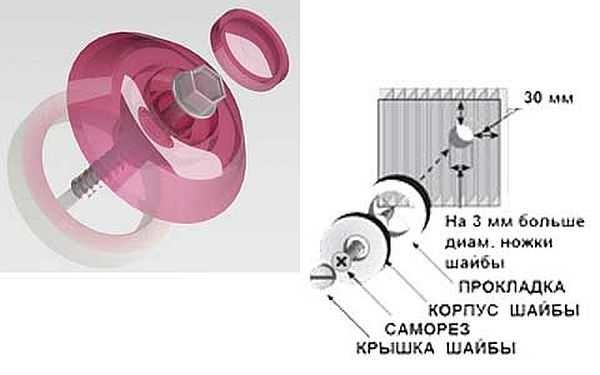
Thermal washers provide a secure fit for polycarbonate
When installing the fasteners, the main thing is not to overtighten. The plastic should not bend. When using a thermal washer, its leg serves as a limiter, and with self-tapping screws, you will have to control the effort.
For the joint of the plates, special profiles are used. They make it possible to compensate for thermal expansion (approx. 3 mm per meter of length) and at the same time guarantee a secure fit. Details about the profiles and all the intricacies of installation are described in the video.
Blueprints
Any of wooden or metal arbors can be covered with polycarbonate. Therefore, there are practically no separate projects. This is just a special case of finishing. We will post several drawings that can be made both of wood and metal in the photo gallery below: turn over, choose.
- Rectangular gazebo with hipped roof

